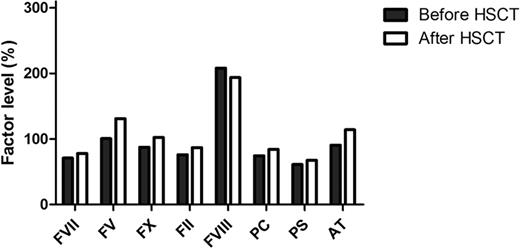Abstract
Abstract 4840
Several components of the clotting system are modified towards hypercoagulability in sickle cell disease (SCD). To date, bone marrow transplantation is the only validated curative treatment of SCD. To our knowledge, whether hypercoagulable state reverse to normal following Hematopoietic Stem Cell Transplantation (HSCT) has never been explored.
To study changes in pro- and anticoagulant factors, the global haemostatic potential and microparticle (MP) levels following HSCT in SCD children.
Four children with severe SCD were explored before and 3 months after HSCT. They were 2 females (6 and 11 years old) and 2 males (6 and 12 years old). Platelet-poor plasma was prepared from 0.109 M citrated blood after a double centrifugation. Before HSCT, patients were suffering from cerebrovascular disease (2), recurrent acute chest syndrome (2) and frequent vaso-occlusive crises (3).
Determination of pro- and anticoagulant factor levels were performed using routine assays on the STAR ® automate. The global haemostatic potential was explored using the Calibrated Automated Thrombogram® method of thrombin generation. Thrombin generation was triggered using 5pM tissue factor and 4μM synthetic phospholipids (PL) with and without 6nM thrombomodulin (TM). Additional experiments were performed using 5pM tissue factor alone. Procoagulant activity of MPs was determined using a capture-based method. Total annexin V positive (A5 MP), red blood cells (RBC MP) and platelets (PLT MP) microparticle levels were measured using a FascCanto II flow cytometer. Calibration was performed using Megamix® beads. RBC MPs and PLT MPs were detected using labeled antibodies directed against glycophorin A and CD42 respectively.
Results of pro-and anticoagulant factor levels are presented in the figure. Those of D-Dimer levels, thrombin generation and microparticle levels are presented in the table.
Three months after HSCT, levels of procoagulant factors VII, V, X, and II, protein C activity, free protein S and antithrombin were higher whereas D-dimers, A5 MP, RBC MP and PLT MP levels were lower in all patients as compared to before HSCT. For 3 of them, endogenous thrombin potential (ETP) and peak height were lower in the presence of thrombomodulin as well as factor VIII levels, and the procoagulant activity of MPs. Reduction of ETP in the presence of thrombomodulin was higher after HSCT.
When thrombin generation was triggered without addition of exogenous phospholipids, the peak was lower in all patients whereas ETP was reduced in 2 patients.
D-Dimer levels, thrombin generation parameters and microvesicle levels in 4 SCD children before and 3 months after successful allogeneic hematopoietic stem cell transplantation
| Parameters . | Before HSCT . | 3 months after HSCT . |
|---|---|---|
| D-Dimers (μg/ml) | 0.72 (0.52-0.91) | 0.29 (0.15-0.46) |
| ETP with TM (nM.min) | 183 (95-271) | 97 (59-204) |
| Peak with TM (nM) | 50.8 (25.2-76.4) | 30.8 (14.5-63.4) |
| Reduction of ETP with TM (%) | 75.6 (62.6-88.5) | 85.4 (74.7-91.7) |
| ETP without PL | 780.5 (714.5-846.5) | 681 (566.3-862.5) |
| Peak without PL | 81.4 (71.5-91.3) | 51.6 (43.5-69.9) |
| Procoagulant MP (nM) | 12.1 (8.4-46.6) | 6.5 (5-9.7) |
| Total A5 MP (events) | 1912 (476-4678) | 903 (340-1273) |
| RBC MP (events) | 408 (216-2316) | 165 (136-202) |
| PLT MP (events) | 1515 (847-3823) | 837 (449-1062) |
| Parameters . | Before HSCT . | 3 months after HSCT . |
|---|---|---|
| D-Dimers (μg/ml) | 0.72 (0.52-0.91) | 0.29 (0.15-0.46) |
| ETP with TM (nM.min) | 183 (95-271) | 97 (59-204) |
| Peak with TM (nM) | 50.8 (25.2-76.4) | 30.8 (14.5-63.4) |
| Reduction of ETP with TM (%) | 75.6 (62.6-88.5) | 85.4 (74.7-91.7) |
| ETP without PL | 780.5 (714.5-846.5) | 681 (566.3-862.5) |
| Peak without PL | 81.4 (71.5-91.3) | 51.6 (43.5-69.9) |
| Procoagulant MP (nM) | 12.1 (8.4-46.6) | 6.5 (5-9.7) |
| Total A5 MP (events) | 1912 (476-4678) | 903 (340-1273) |
| RBC MP (events) | 408 (216-2316) | 165 (136-202) |
| PLT MP (events) | 1515 (847-3823) | 837 (449-1062) |
Data are expressed as median (range).
Procoagulant and anticoagulant factors levels before and 3 months after hematopoietic stem cell transplantation (HSCT). Data are expressed as median values. PC: protein C activity, PS: free protein S, AT: antithrombin.
Procoagulant and anticoagulant factors levels before and 3 months after hematopoietic stem cell transplantation (HSCT). Data are expressed as median values. PC: protein C activity, PS: free protein S, AT: antithrombin.
Although the number of patients included is too small to allow statistical analyses, the results of this preliminary study showed that there is a trend toward the resolution of the hypercoagulable state of SCD 3 months after successful allogeneic HSCT. Indeed, after this procedure, we observed a trend toward the reduction of the consumptive coagulopathy as shown by higher levels of pro- and anticoagulant factors and lower D-dimers levels. We also observed a trend toward an improvement of the coagulation imbalance as shown by lower thrombin generation, higher response to thrombomodulin and reduced levels of procoagulant MP deriving both from red blood cells and platelets. These findings need to be confirmed with more cases and longer follow-up especially when patients are no more under Ciclosporin A.
No relevant conflicts of interest to declare.
Author notes
Asterisk with author names denotes non-ASH members.


This feature is available to Subscribers Only
Sign In or Create an Account Close Modal